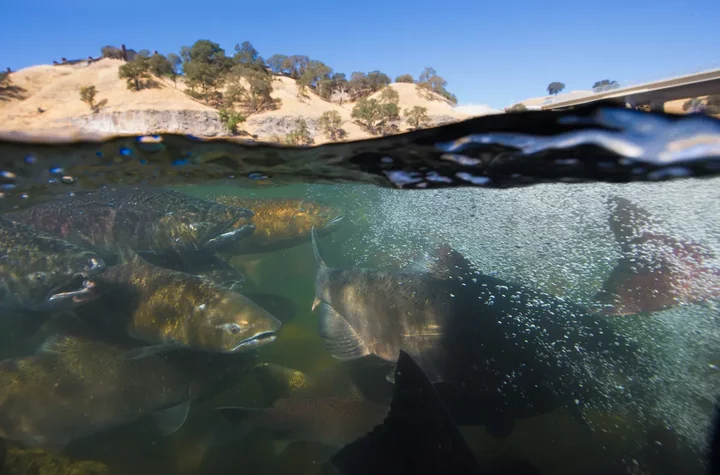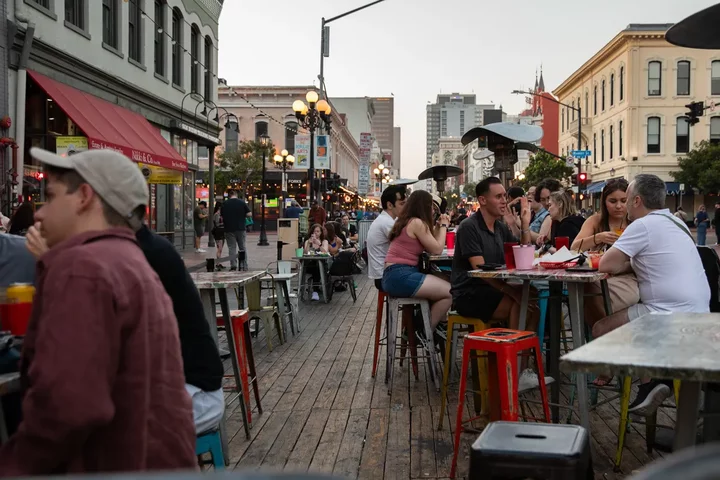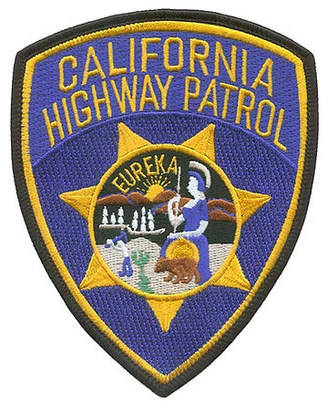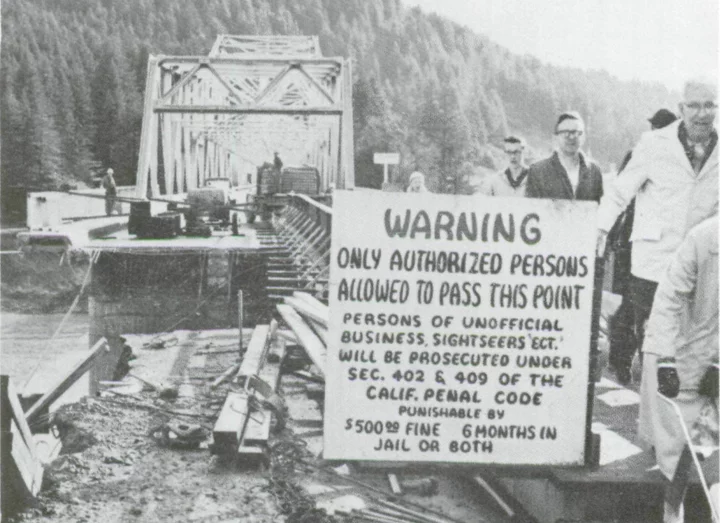‘No Way, Not Possible’: California Has a Plan for New Water Rules. Will It Save Salmon From Extinction?
Alastair Bland / Monday, Dec. 16, 2024 @ 7 a.m. / Sacramento
Adult fall-run Chinook salmon congregate near the Nimbus Hatchery Fish Ladder on the American River in Sacramento County on Oct. 15, 2012. Gov. Newsom’s administration is pushing for a new set of Delta rules that it says would balance the water supply needs of growers and cities with the needs of salmon. Photo by Carl Costas, California Department of Water Resources.
The Newsom administration is refining a contentious set of proposed rules, years in the making, that would reshape how farms and cities draw water from the Central Valley’s Delta and its rivers. Backed by more than $1 billion in state funds, the rules, if adopted, would require water users to help restore rivers and rebuild depleted Chinook salmon runs.
The administration touts its proposed rules as the starting point of a long-term effort to double Central Valley Chinook populations from historical levels, reaching numbers not seen in at least 75 years. But environmental groups have almost unanimously rejected it, saying it promises environmental gains that will never materialize and jeopardizes the existence of California’s iconic salmon and other fish.
“There is no way the assets they’ve put on the table, water and habitat combined, are going to achieve the doubling goal — no way, not possible,” said Jon Rosenfield, science director with San Francisco Baykeeper.
Dubbed Healthy Rivers and Landscapes but better known as “the voluntary agreements,” the proposal is one of two pathways for state officials as they update a keystone regulatory document called the Bay-Delta Water Quality Control Plan, which was last overhauled in 1995.
With the ecosystem of the Bay-Delta in the throes of collapse, the set of rules is critical to determining how much water flows through the Delta for salmon and other species and how much is available for growers and cities in the Central Valley and Southern California.
Once vital to indigenous cultures and the coastal ecosystem, Chinook salmon and other native fish have declined for decades due to dam operations, water diversions, increased water temperatures and marine food web issues. Numbers of spawning adult Chinook have dropped so low that all commercial and recreational salmon fishing has been banned for two years in a row, and preliminary numbers this year show no signs of recovery.
State officials from multiple agencies have lauded the Healthy Rivers program — which would meter out flows for fish while mandating restoration of floodplains and other river features — as their preferred option for updating the plan.
California’s most influential water districts, serving tens of millions of people and most of the Central Valley’s farmland, have rallied behind the state’s preferred option, which has taken center stage during public workshops since November.
Newsom administration officials have worked on these rules for years during negotiations with the San Joaquin Valley’s Westlands Water District, the nation’s largest agricultural water provider, the giant Metropolitan Water District of Southern California and other water users.
California Resources Secretary Wade Crowfoot described the proposal as “a new and strengthened approach” that will protect both the environment and the water supply.
Crowfoot told the water board that the proposed rules would do “a good job working to balance all of (Californians’) needs, and ultimately help the environment to recover in ways that’s workable for communities across our state.”
Such a balance has long eluded state officials.
“This is progress,” Chuck Bonham, director of the California Department of Fish and Wildlife, said at a November water board workshop. “It’s gone on so long. It’s time.”
Back in 2020, Gov. Gavin Newsom endorsed the “voluntary agreement” approach. “Today, I am committing to achieving a doubling of California’s salmon population by 2050. These agreements will be foundational to meeting that goal,” he wrote in a CalMatters opinion piece.
The rules would do “a good job working to balance all of (Californians’) needs, and ultimately help the environment to recover in ways that’s workable for communities across our state.”
— California resources Secretary Wade Crowfoot
Nina Hawk, the Bay-Delta Initiatives group manager with the Metropolitan Water District — which provides water that serves 19 million Southern Californians — said the Newsom proposal would create an equitable pathway to meeting human and environmental water demands.
“It is important that we try to balance what the state board defines as beneficial uses … both for the environment and for farms, in a way that looks at the integrity of the water system and also for the state of California’s natural resources and its economy,” Hawk said.
Kevin Padway of the Zone 7 Water Agency, which serves 270,000 East Bay residents, encouraged the water board to adopt the rules, commending them as an “immediately implementable” route to balancing water demands for people and environmental uses.

A drone provides a view of water pumped from the Harvey O. Banks Delta Pumping Plant into the California Aqueduct, which delivers Northern California river water to Southern California, on Jan. 20, 2023. Photo by Ken James, California Department of Water Resources
But environmentalists aren’t sold. Some have even refused to call it by its formal name, saying it’s a euphemism with no bearing on “healthy rivers.” They say the rules would favor water users, allowing cities and farms to draw so much water from the Delta and its tributary rivers that salmon will continue their long decline. They say the proposed rules simply don’t offer fish the water they need, let alone support the state’s salmon rebuilding mandate.
“If you’re diverting more than half of a river’s flow, you are guaranteeing negative population growth” of salmon, said Gary Bobker, Friends of the River’s program director.
The complex flow rules could even allow growers to entirely drain some rivers in critically dry years, according to Barry Nelson, a water policy analyst with the Golden State Salmon Association who spoke at a recent board workshop.
“Dewatering rivers during droughts would be completely consistent with the Bay-Delta Plan,” he said.
The State Water Resources Control Board is the agency with the authority to approve the rules. A public hearing and vote could come in 2025.
The water board’s other option would require strict minimum flows in rivers. Water users say those rules would have unacceptable impacts on farms, hydropower and communities — including planned housing projects — while environmentalists and tribes laud it as more protective of fish. It would ensure that rivers contain an average of 55% of the total water available in the watershed at a given time — a measure called unimpaired flow.
While momentum has built behind the state’s Healthy Rivers plan, the state water board could still go either way with their vote. It is even possible that officials adopt both options, with the unimpaired flow pathway reserved as a regulatory backstop, should the Newsom proposal fail, or as concurrent rules applied to waters users who opt out of the voluntary agreements.
Doubling Chinook runs — is it a stream dream
A longstanding mandate requires fishery and water managers to double the Central Valley’s population of naturally reproducing Chinook salmon from levels observed between 1967 and 1991. This would translate into an average of 990,000 spawning Chinook each year, almost 10 times recent averages.
State officials say their Healthy Rivers plan would help to realize this goal. Around year-eight — when the program could be extended — officials hope to be about 25% of the way to the doubling goal, said Louise Conrad, lead scientist with the state Department of Water Resources.
“Salmon runs could potentially be extinct by then with the flow assets they’re putting forward.”
— Ashley Overhouse, Defenders of Wildlife
Officials with the National Marine Fisheries Service, in a January letter to the state, said the eight-year timeframe “is concerning, given the dire status of native fish species within the Sacramento River Basin and Delta.”
The U.S. Environmental Protection Agency, in comments emailed to the Water Board in January, noted the light water allowances in critically dry years.
“EPA is concerned that the total volume and timing of Delta inflow and outflow provided under the proposed VA (voluntary agreement) alternative relative to baseline is not large enough to adequately restore and protect aquatic ecosystems,” the agency wrote.

Fall-run Chinook salmon migrate and spawn in the Feather River near the Feather River Fish Hatchery in Oroville on Nov. 15, 2024. The iconic fish are depleted from a combination of water diversions in the Delta, increased water temperatures and other factors. Photo by Xavier Mascareñas, California Department of Water Resources
This target of doubling Chinook is nothing new. The almost legendary “doubling goal” has been on the books since the early 1990s, when federal law set the deadline for 2002.
Now the state’s proposed rules would punt it to 2050 — what salmon advocates say is much too far away for a species already on the brink and a vanishing fishing industry.
“Salmon runs could potentially be extinct by then with the flow assets they’re putting forward,” said Ashley Overhouse, Defenders of Wildlife’s water policy advisor.
Representatives of California tribes, who historically relied on Chinook as a dietary mainstay, say they were excluded from planning discussions.
“The only people that have been at the table talking about the voluntary agreements are water agencies, water contractors, irrigation districts, and private companies,” said Gary Mulcahy, government liaison for the Winnemem Wintu Tribe. “They (state officials) have excluded tribes, disadvantaged communities, environmental justice communities for nine years.”
State officials “have excluded tribes, disadvantaged communities, environmental justice communities for nine years.”
— Gary Mulcahy, Winnemem Wintu Tribe
But the flow rules environmentalists and tribes prefer would cut deep into urban and agricultural water supplies, causing “impacts far and wide” on water exports from the Delta, storage in upstream reservoirs and hydropower production, said Jennifer Pierre, general manager of the State Water Contractors, which represents 27 water agencies that serve 750,000 acres of farmland and 27 million people.
Farmers, she said, would experience substantial permanent economic losses, forcing widespread fallowing of their crops. San Joaquin Valley growers would lose more than a quarter of their water in dry years, and 13% on average for all years, according to the draft rules.
Thaddeus Bettner, executive director of the Sacramento River Settlement Contractors — a group of farmers who largely grow rice — said it would force as much as 30% of his district’s 450,000 irrigated acres out of production, with harder impacts on growers with little groundwater to fall back on.
Rice farmer Jon Munger, with 13,000 acres on the east side of the Sacramento Valley, said, in some years, the unimpaired flow approach favored by environmentalists could strip him of virtually all of his water in summer months. His groundwater supply is very limited.
“We wouldn’t have any water to grow rice,” he said.
That option would also squeeze residential water use. The Placer County Water Agency, which serves about a quarter-million residents northeast of Sacramento, would lose almost half its supply, threatening initiatives to accommodate a growing population, said General Manager Andrew Fecko.
It would cost Southern California a big chunk of its municipal water, too.
Under the environmentalists’ option, “we wouldn’t have sufficient water supply. It would be a decline at the taps, it would be a decline for businesses.”
— Nina Hawk, Metropolitan Water District of Southern California
“We wouldn’t have sufficient water supply,” said Hawk at the Metropolitan Water District. “It would be a decline at the taps, it would be a decline for businesses.”
Billions of dollars in new salmon habitat
The program proposes restoring 45,000 acres of structural habitat, like floodplains, tidal marshes, in-river piles of woody debris and gravel spawning beds over the next eight years.
Thousands of acres are already completed or underway. This, according to Overhouse at Defenders of Wildlife, leaves roughly 30,000 planned acres that would be brand new additions to the ecosystem — which she and others say would mute the promised benefits of the program.
All of this will cost money, and to date $2.4 billion in public funds have been secured to support the flow measures and the habitat restoration. Another $500 million may be needed.
The state’s proposed rules would allocate to the Sacramento River system between 100,000 and 700,000 acre-feet of water per year, depending on how much precipitation has fallen. But environmentalists say this isn’t nearly enough. They also worry that regulatory loopholes would allow future water projects — such as the Sites Reservoir, for which Newsom advocated at a public appearance last week — to divert water that would be protected if the state adopted unimpaired flow rules.
“It is not an accident that they haven’t solved this problem,” Nelson, with the Salmon Association, said. “The VAs (voluntary agreements) and the Delta tunnel and Sites are a package.”
Some conservationists are optimistic about the state’s proposal.
Rene Henery, California science director with Trout Unlimited, thinks more habitat and water — especially in dry years — will be needed to protect salmon. But he also thinks the rules could succeed, as long as it’s just the first step of many in a flexible and collaborative restoration process — something he and a team of colleagues are trying to initiate with a state-funded project called Reorienting to Recovery.
UC Davis fish biologist Carson Jeffres, who has studied floodplain restoration projects, also said the salmon doubling objective is achievable through the Newsom proposal as long as state officials “have the courage to be nimble and adjust and adapt if it looks like things aren’t going as planned.”
Tribal water rights advocate Regina Chichizola, executive director of Save California Salmon, rejected the Newsom administration’s notion that the state balances competing needs and demands.
“We’ve compromised so much that we’re facing an extinction crisis, that tribes don’t have fish for ceremonies,” she told the board in an emotional public comment last week.
“Of course I want to make sure that all of the cities have access to water, but in the end agriculture is going to have to use less water,” she said. “The job of the water board is not to make everyone happy, it’s to protect beneficial uses and clean water, and if the salmon go extinct on your watch, that’s something that you’re going to have to tell your grandkids about.”
###
CalMatters.org is a nonprofit, nonpartisan media venture explaining California policies and politics.
BOOKED
Today: 11 felonies, 11 misdemeanors, 0 infractions
JUDGED
Humboldt County Superior Court Calendar: Friday, Aug. 22
CHP REPORTS
Us101 N / Kenmar Rd Ofr (HM office): Traffic Hazard
ELSEWHERE
RHBB: Plan to Reduce Central Ave. Lanes Sparks Debate in McKinleyville
RHBB: New Traffic Schedule Announced for Highway 36 at Grizzly Creek Slide
RHBB: McKinleyville’s Former Kmart Site Could Soon Get 22 New Signs
RHBB: Two-Vehicle Crash on U.S. 101 Near Bayside Sends One to Hospital
California New Laws for 2025: Cannabis Cafes and Entertainment Zones
Jenna Peterson / Monday, Dec. 16, 2024 @ 7 a.m. / Sacramento
Customers in an outdoor seating area outside a restaurant in downtown San Diego on July 24, 2024. Photo courtesy of Adriana Heldiz.
Starting Jan. 1, alcohol and cannabis sales could expand in some parts of California thanks to two new laws that aim to increase central city foot traffic, which has yet to fully recover from the COVID-19 pandemic.
Senate Bill 969, authored by state Sen. Scott Weiner, will let local governments designate “entertainment zones,” where bars and restaurants can sell alcoholic beverages for people to drink on public streets and sidewalks.
Some organizations, such as the California Alcohol Policy Alliance, oppose SB 969 because it could contribute to drunk driving accidents and increased alcohol mortality rates.
Gov. Gavin Newsom signed a similar bill in 2022, but it was limited to San Francisco. In September, the city experimented with an entertainment zone for Oktoberfest and reported at least 10 times more foot traffic than the 2023 celebration.
“Getting people out in the streets to enjoy themselves is critical for communities across our state to bounce back from the pandemic,” Wiener, a San Francisco Democrat, said in a statement.
There’s still a lot of broader economic uneasiness, among business leaders and Californians concerned about the cost of living. Newsom has embarked on a jobs tour.
AB 1775 legalizes Amsterdam-style cannabis cafes, allowing lounges to also sell food and drinks that aren’t pre-packaged. After opposition from the American Heart and Lung Association and Newsom’s veto of a similar bill in 2022, AB 1775 includes additional protections for workers against secondhand smoke.
“Lots of people want to enjoy legal cannabis in the company of others,” bill author Assemblymember Matt Haney, also a San Francisco Democrat, said in a statement. “And many people want to do that while sipping coffee, eating a sandwich, or listening to music. There’s no doubt that cannabis cafes will bring massive economic, cultural and creative opportunities and benefits to our state.”
###
This story was written by former CalMatters politics intern Jenna Peterson.
CalMatters.org is a nonprofit, nonpartisan media venture explaining California policies and politics.
TINY FOOTPRINTS: Shampoo Bars, the Supreme Sustainable Stocking Stuffer!
Ashley Thomas / Sunday, Dec. 15, 2024 @ 7 a.m. / Tiny Footprints
Shampoo bars — soap for your hair, minus the plastic! Photo by Sarah Chai via Pexels.
While it’s beyond my capacity to fathom, the internet’s agreed-upon statistic for shampoo waste in the US is 552 million bottles annually. It’s a jaw-dropping number. There’s a level of optimism that comes along with recycling plastic containers—what I’ve heard referred to as “wishcycling.” Unfortunately, about 85% of plastic packaging is destined for landfills, and only about 9% is actually recycled.
Luckily, there are ways to entirely forgo the need for plastic waste (or reduce it) whilst lathering your tresses with goodness. Let me name some options for you:
1. Bubbles: Located at 1031 H Street in Arcata, this sweet little shop carries several shampoo bar options. If you haven’t ventured into the realm of shampoo bars, let me elaborate. They look like a bar of soap, lather up nicely, and are formulated for various haircare needs. The great thing about them is that they require zero plastic, and are usually packaged with recycled paper. Just make sure to store them in a tray that allows them to dry out between uses, which ensures their longevity. In general, one shampoo bar is equivalent to two bottles. Bubbles also makes their own liquid shampoo in-house, where you can return the bottle for a refill and get 25% off. My favorite part is that you can choose from an impressive menu of scents and customize it to any vibe. I chose ylang ylang and jasmine, and it’s pretty intoxicating.
2. North Coast Co-op: Both the Eureka and Arcata branches carry a wide array of bulk shampoos. Simply bring your own container and skip on the single-use plastic bottle altogether. Jessicurl, Shikai, Griffin, Dr. Bronner’s, and Giovanni are just a few of the shampoo options they have available. They also have a ton of shampoo bars in stock.
3. Ewe So Dirty: While I haven’t tried it myself, a friend of mine swears by this local company’s shampoo bars. And since it hails from Humboldt, it’s extra sustainable because it didn’t have to be shipped far. They have a large selection of scents and can be found at the Arcata Co-op.
4.If you’re attached to a particular brand of shampoo you can’t find in bulk, another way to reduce the impact is considering frequency of use. A WebMD article from this year states that many people shampoo their hair more frequently than is healthy. While those of us who work out intensely, sweat more, or have oily hair may require more frequent washings, the consensus of experts is that it’s fine to go a couple/few days between shampoos, or more depending on hair texture. I’m not here to throw shade on anyone’s established ritual. If you’ve found what works for your hair type, congrats! But if you’re not sure, it’s worth experimenting. Going from daily shampoos to every other day, for example, could translate to better hair health and half the plastic waste.
###
Ashley Nichole Thomas is a marriage and family therapist who’s passionate about shrinking her carbon footprint. In her free time she writes fantasy novels, and remains unconvinced that fairies don’t exist.
(VIDEO) ‘Can’t Fight the Tide’: King Tides Flood Falafelove Eatery in King Salmon
Isabella Vanderheiden / Saturday, Dec. 14, 2024 @ 12:56 p.m. / :)
This morning’s super-high king tide sent a surge of seawater into King Salmon’s Mediterranean eatery Falafelove, leaving nearly a foot of standing water inside the building. However, instead of getting bogged down by the bad weather, Falafelove owner Avishai Leibson put a positive spin on the situation, recording a video of a customer kayaking into the restaurant jokingly asking, “You guys open today?”
“Yeah, we’ll open around noon,” Leibson replies in the video. “You know, just another day at Falafelove.”
Once the tide started receding around 11 a.m., Leibson and his team began pumping water out of the building and cranking the dehumidifiers. They opened for business, as predicted, right around noon.
“You can’t fight the tide,” he told the Outpost during a brief phone interview. “My life philosophy is equal parts ‘Life is what you make it’ and ‘Life is how you take it.’ You gotta have a positive attitude, regardless of the stuff that gets in your way. I mean, I got my health and I got my business up and running. At least we’re gonna get a little bit of social media attention from this, you know? It’s all about maintaining a positive outlook.”
Asked whether the business suffered any water damage, Leibson noted that the building had endured years of minor flooding without any significant issues.
“I do want to thank [our employees] and our patrons who’ve supported us and extended their concerns and well wishes,” he added. “This is just a funny, viral moment we can share with Humboldt.”
King tides will continue through Sunday, with coastal flooding possible between 8 and 11 a.m. Stay dry out there, folks!
###
THE ECONEWS REPORT: A Geological Perspective on Last Week’s Quake
The EcoNews Report / Saturday, Dec. 14, 2024 @ 10:47 a.m. / Environment
Image: Stable Diffusion.
What’s the difference between a strike-slip fault and a subduction zone? Can a local 7.0-magnitude earthquake? And what on earth was going on with all that weird footage of Humboldt Bay last week, in the wake of the quake?
Jay Patton, of Cal Poly Humboldt’s geology department, is here to talk us through it all. Check out his blog here.
###
Good Samaritans Use CPR to Save 4-Year-Old Injured in Multi-Vehicle Crash on Highway 101, CHP Says
LoCO Staff / Saturday, Dec. 14, 2024 @ 10:03 a.m. / Traffic
Press release from the California Highway Patrol:
On December 13, 2024, at 4:37 pm, Humboldt Communications Center (CHP Dispatch) received 9-1-1 calls for a multi-vehicle crash, where both vehicles were upside down in Rattlesnake Creek.
Todd McKay, 47 years old of Garberville, CA, was driving his Toyota 4-Runner northbound on US 101, at Spy Rock Road, during the heavy rainstorm. McKay’s 4-Runner began to hydroplane and ran off the roadway. The 4-Runner drove up the embankment and overturned, landing on its roof. The 4-Runner slid into the southbound lane, directly in front of a Toyota Rav 4, driven by Anthony Fair, 56 years old of Philo, CA. The two vehicles collided, and both went down the embankment into Rattlesnake Creek. Both vehicles landed in the creek upside down and were nearly submerged as the creek continued to rise due to the heavy rain fall.
Good Samaritan’s Barrett Thomas and Abram Hill (an off-duty volunteer fire fighter with Leggett Valley Fire and Rescue and Piercy Volunteer Fire Department) were driving, separately, through the area when they noticed vehicle debris in the roadway. Both pulled over and checked down the embankment. Thomas pulled Fair and his son to safety out of the creek and noticed McKay’s vehicle downstream. Hill jumped from the creek bank onto the upside-down vehicle, just as two of McKay’s children emerged from the vehicle. Hill helped the children to the creek bank as McKay emerged from the vehicle with his 4-year-old child. Hill helped McKay and his child up to the side of US 101. Hill recognized the 4-year-old was not breathing and did not have a pulse. Hill and Thomas began CPR. Not long after starting CPR, the 4-year-old’s pulse returned and shortly after, the 4-year-old was breathing without assistance. The 4-year-old was transported to Howard Memorial Medical Center and then to UC Davis Medical Center and expected to make a full recovery.
All occupants of both vehicles received minor injuries from the crash.
The CHP Garberville Office is extremely grateful for Abram Hill and Barrett Thomas for their quick actions in performing CPR in the pouring rain, ultimately saving the life of McKay’s 4-year-old child.
HUMBOLDT HISTORY: Decembers in Humboldt Have Always Been Cursed
Kathryn L. Corbett / Saturday, Dec. 14, 2024 @ 7:30 a.m. / History
A temporary foot bridge was built across the break at the north end of the Scotia-Rio Dell Bridge in 1964 by Pacific Lumber Company and PG&E employees. Photo via the Humboldt Historian.
When I first came to Humboldt County in January of 1947, I was told that I was lucky to have missed the 21st of December. Folklore in the area says that something awful usually happens on that date. Since I didn’t have any other choice of location if I was going to live with my husband, a native of the area, I decided to pay no attention to the silly rumor.
Until 1954 it was a rumor, and then we had a 7.5 on the Richter scale earth quake on December 21st. Then the next year on that fateful date we had a flood. We thought it was a big one just because we did not know what was in store for us December 21, 1964.
It had rained for days in December and all of a sudden it cleared around the 16th or so. In Eureka we basked in the cold sunlight; after all, it was better than rain, we thought. And then it hit. It seems that the back country snow suddenly started melting when a warm weather rain front moved in. The amount of water which started flowing in the Eel, the Klamath and the Smith was unbelievable. We became completely isolated in the Humboldt Bay area. To the south on 101 we had roads but no bridges. To the east on 299 to Weaverville we had bridges and no road. Highway 101 north abruptly stopped at Klamath where the bridge had gone out. We stayed in this condition for over six weeks.
Our grocery stores were strikingly bare and were supplied by air lift, the largest single civilian population to be taken care of thus since the Berlin air lift. The Salvation Army sent giant relief planes full of blankets, etc., and the Safeway stores sent their planes in, loaded with groceries. I still recall the almost-empty shelves in some places, and in others, piles of very fine fresh fruits.
The county was under martial law, with the airport at McKinleyville being under the control of an Army colonel, the only governing authority who mattered in our lives. He definitely outranked God, even if we were sending up fervent prayers for the unceasing water rising in our rivers. The rivers just kept rising. You can’t imagine so much water. We lived by the radio because our lives were regulated by what we heard over the air waves. The telephone, which we weren’t supposed to use, was commandeered for official business. But most of us phoned our relatives outside the area as soon as we could get a line, which was not easy to procure. A lot of phone calls went out at strange hours and were gratefully received by anxious relatives far from Humboldt.
The story I want to tell is about the Humboldt State University student who was out of the county, home for Christmas, when the flood struck and his amazing plan for moving without ever returning to the area.
While home for Christmas, he procured a job which had to be taken immediately. There he was, with a job; however, his belongings were in his student quarters in Humboldt. He had no way to get his possessions as there was no access to the county. Furthermore, there seemed no promise in the future for him to get here to regain his student properties, like books and clothes. There was no auto transport into or out of the county.
By telephone he and his roommate came up with a unique scheme which was predicated upon the immense goodwill toward our fellow humans which existed in all of us at the time. It was simplicity itself. Anyone leaving the county by air merely phoned the number posed on the numerous Humboldt State bulletin boards and volunteered to take one package out as part of one’s luggage. The package was then delivered to your home shortly before departure time, and you were given a quarter. Airport lockers were only 25 cents for 48 hours at the time. You also received an envelope stamped and addressed to the young man who was moving. You were was instructed to deposit the package in the locker, put in the quarter, remove the key, and put the key into the envelope which you then mailed.
I don’t know how many of us it took to get him moved, but move him we did.
Then there was the Oregon Tech basketball team who had flown down to Arcata to play Humboldt. They played their game all right, but then the flood came and they couldn’t get home. We had an almost-empty fraternity house because its occupants had gone home for Christmas. The Oregon basketball team moved into the fraternity house, and they even arranged to use the cars which some of the fraternity men had left when they flew out. No, they were not squatters; all was arranged by telephone.
How did Humboldt get all the students back? Our President, Siemens, and our Dean of Students, Karshner, came up with a brilliant scheme. Remember the county was absolutely isolated by road when it came time for school to start in January. They wrote to each student and advised him or her to fly to Redding, where a special airlift arranged for transport to Humboldt, complete with college buses in readiness to transport students from our airport to the campus. Nature intervened with a couple of very mean tricks.
The San Francisco airport, the rendezvous for Arcata-McKinleyville, was fogged in for 24 hours or so. Then when they assembled at Redding, a snowstorm came which caused the shuttle to Arcata-McKinleyville to be put off for one night. The President and Dean got the American Red Cross in Redding to take over, and somehow nearly 1,000 students were put up over night in Redding.
Yes, they did get back to campus.
Most of us cringe as the 21st of December comes around each year. We wait in anticipation for the unknown mystique of the forces of nature.
###
The story above is excerpted from the November-December 1993 issue of the Humboldt Historian, a journal of the Humboldt County Historical Society. It is reprinted here with permission. The Humboldt County Historical Society is a nonprofit organization devoted to archiving, preserving and sharing Humboldt County’s rich history. You can become a member and receive a year’s worth of new issues of The Humboldt Historian at this link.






